- Home
- slideshows
- miscellaneous
- I stayed in an abandoned grain silo that was transformed into one of the trendiest boutique hotels in the world, and it definitely lived up to the hype
I stayed in an abandoned grain silo that was transformed into one of the trendiest boutique hotels in the world, and it definitely lived up to the hype
The Silo Hotel opened in March 2017 at Cape Town's V&A Waterfront, a tourist hub with a shopping mall, ferris wheel, several high-end hotels and restaurants, and a marina. With around 24 million visitors every year, The Waterfront is the most visited destination in South Africa.

Prior to this ultra-luxe makeover, the hotel space was the grain-elevator shaft of an abandoned grain silo from 1924 through 2001. The actual silos now house the Zeitz Museum of Contemporary Art Africa — a completely separate entity from the hotel.
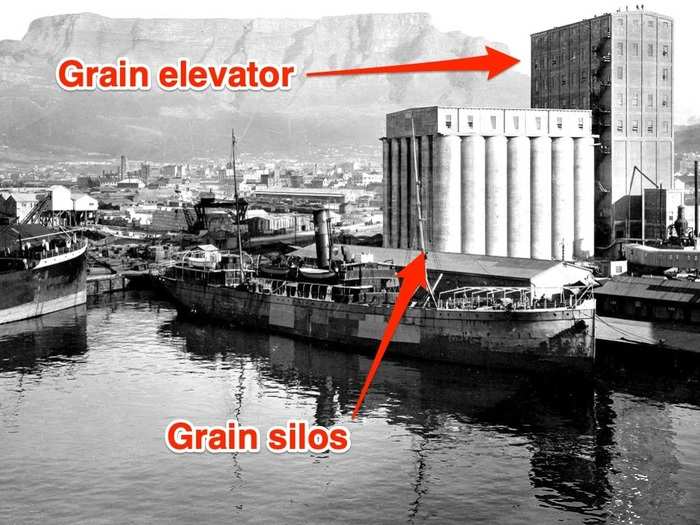
Source: The Royal Portfolio
Now, at 11 stories tall — including the rooftop — this shaft encompasses 28 suites, a spa, gym, a private art collection, conference rooms, and three eateries.
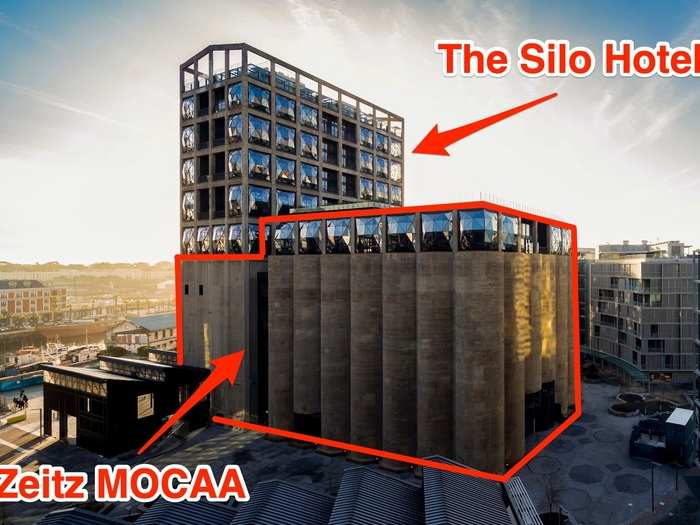
Source: The Royal Portfolio
Since opening the hotel has made several top hotel lists, and was even a contender for Africa's best new hotel, according to CNN. I decided to try it out on my latest trip to Cape Town to see if it was worth the hype.

This was my third trip to the Mother City — the first time I spent around six months there studying and learning the culture. Because of that, I have a pretty good idea of the little things that make Cape Town special, like its bursting art scene, love for music, and affinity for natural beauty.
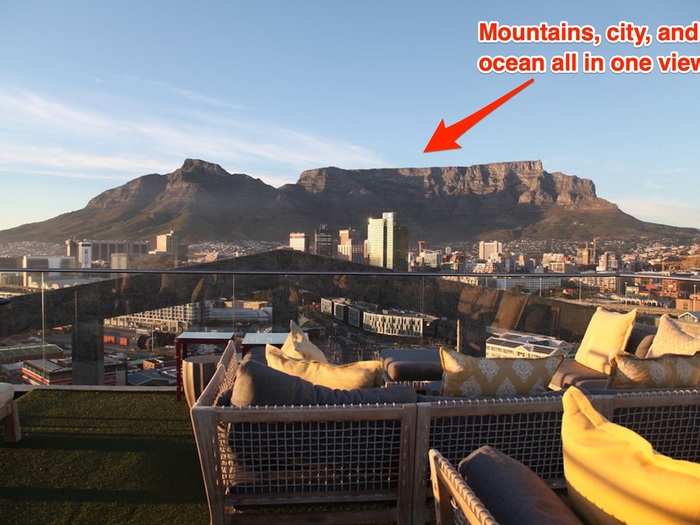
Cape Town as a whole — I'm talking really big picture here — is a complicated city with stark divisions of class due to the systemic racism of Apartheid. This has resulted in some mega-luxury neighborhoods, including where all the high-end hotels are located.
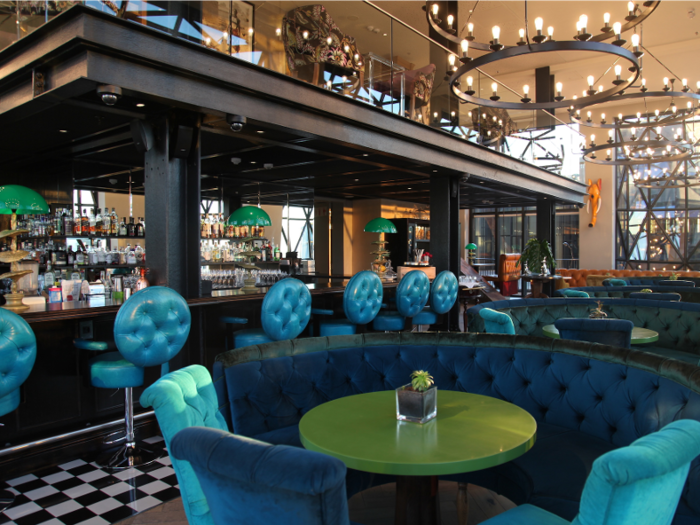
Source: fin24, The Guardian, The Washington Post,
My experience with The Silo is that it's the embodiment of almost everything I love about this city. Unlike my experience visiting some of its price-point competitors, that feeling was apparent to me from the moment I walked into the hotel lobby.

I was around half an hour earlier than I anticipated when booking my stay, but somehow the hotel staff knew who I was before I even introduced myself. They greeted me at my Uber and whisked away some of my luggage — I was left carrying only a few bags myself.
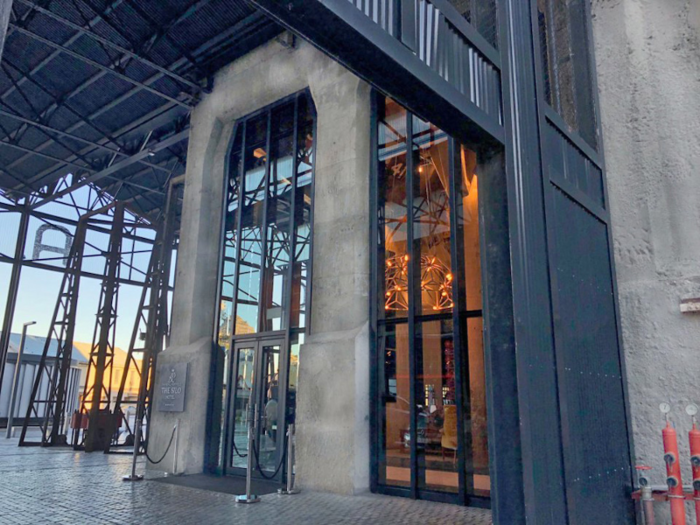
The ground floor has an information desk, a seating area decorated with beautiful works of modern art, and an automatic glass sliding door that was so clean I honestly came close to walking into it several times during my stay.

Because of the museum below and next to the hotel, The Silo reception desk is on the sixth floor. This placement makes for a great view and also added a feeling of privacy and exclusivity from knowing anyone can't just walk in off the street and wander around your hotel.
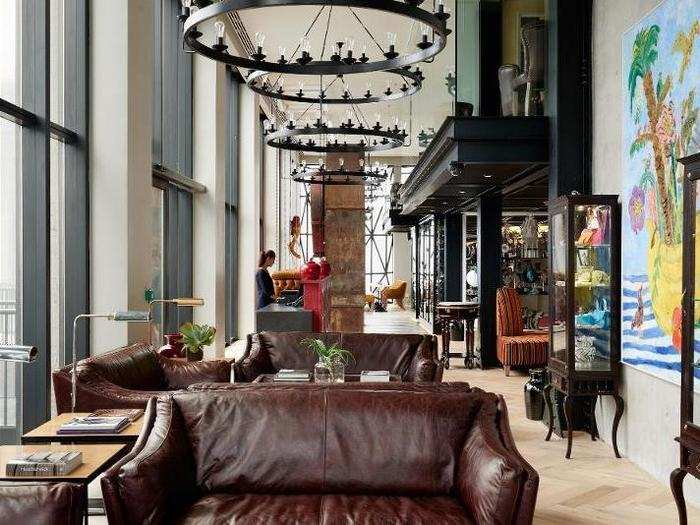
Stepping off the elevator I walked through a mini boutique toward the front desk. I walked up to staff members laughing with each other, smiling wide at me, and welcoming me into their little crew. It immediately took all the boujiness out of the hotel — you know, until I saw all the rooms — and dumped all the charm right in.
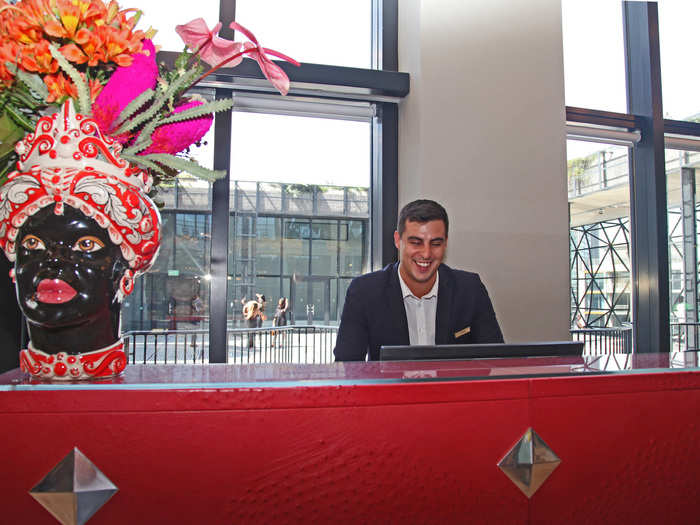
I was offered coffee right away — and since it was 9:30 a.m. you better believe I took it — and got checked in. Sensing my need to be fed, they offered breakfast — again, I'm in — and showed me to the main dining area for the Granary Café.
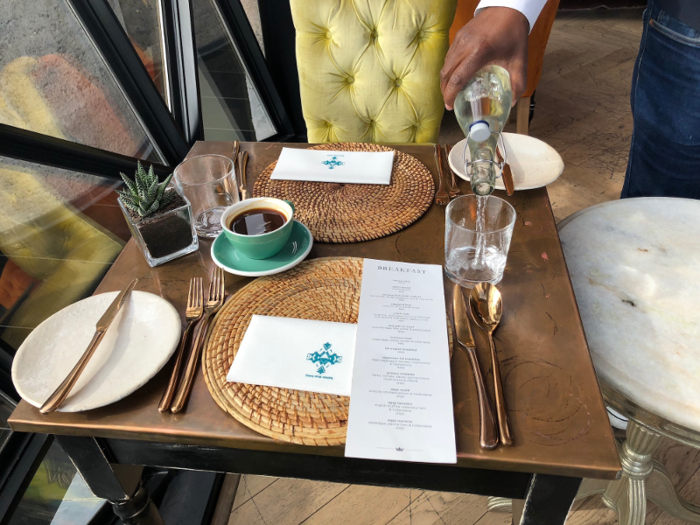
Alex — my lovely waiter — sat me at a table in the corner. Now, "the corner" may sound weird but in this hotel that means you're drowning in sunlight, nestled in the crux of two oversized, pillowing windows. The windows were a key feature for the redesign, they're meant to glisten like gems from the outside — thanks to the geometric shapes made by the crossing of iron beams — and look like they're ever so slightly inflated.

Source: The Royal Portfolio
Alex brought over a menu, and then said he'd bring over the continental breakfast. So the continental was supposed to be an appetizer? Okay! I was just going with the flow.
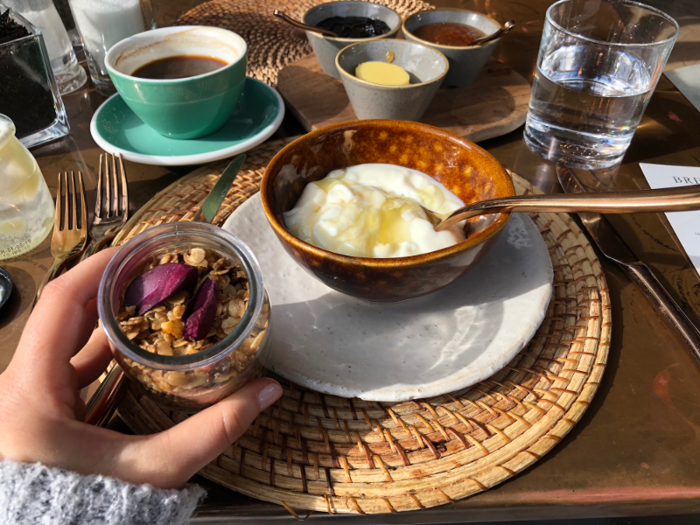
But the joke was on me. This was no appetizer, this was a perfectly fine breakfast for two: a carousel-looking sculpture adorned with two servings of flavored yogurt, muesli, sliced fruit, berries, a cheese plate, and smoked salmon.
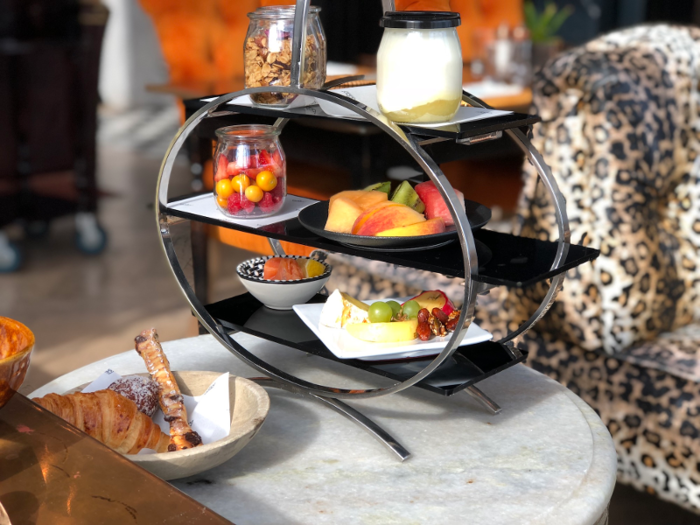
There was also a basket of baked goods including a koeksister — the Cape Malay spiced breakfast doughnut — and an assortment of jams.
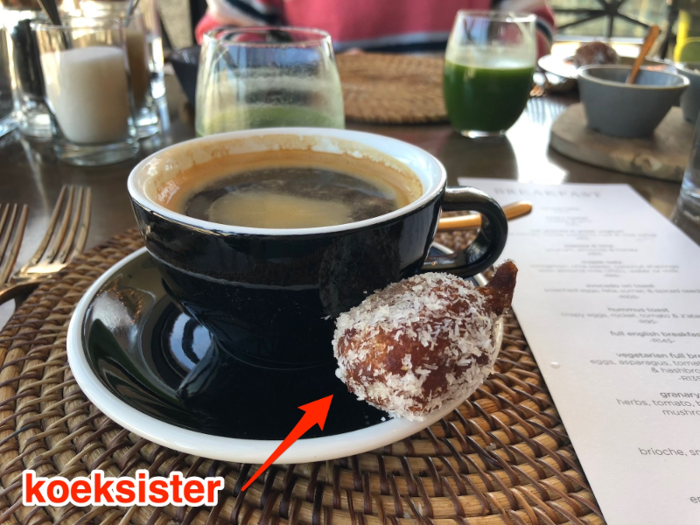
Alex was surprised when I said I wasn't ordering a main breakfast dish, but I was perfectly satisfied.
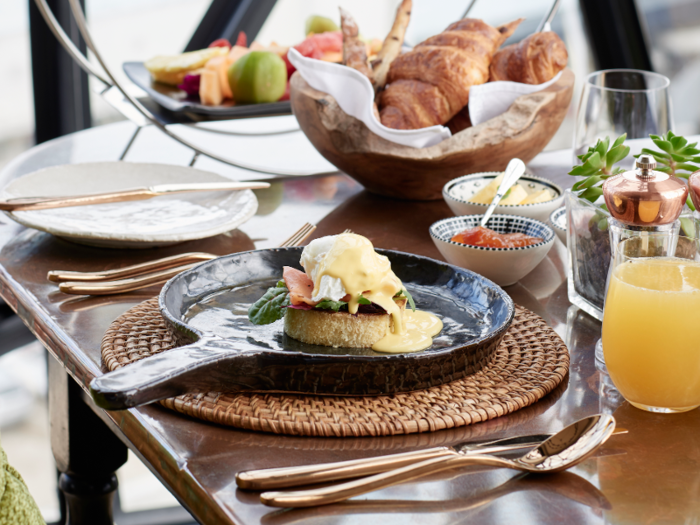
Another staff member came over to let me know my room was ready so I finished up, thanked Alex, and was escorted upstairs. Typically a guest will be given a tour of the hotel and its facilities at this point, but since my tour was a little more extensive we waited until a bit later.
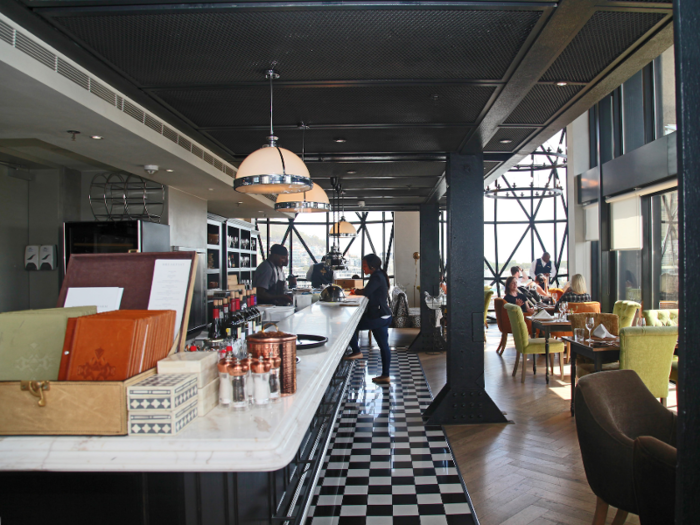
The hotel had reserved a family suite for me and my guest — it's one of 10 duplexes in the hotel. I walked in and, honestly, I didn't know what to look at first. There was this modern staircase directly in front of me, an eight-person dining table to my left, and art on the walls.
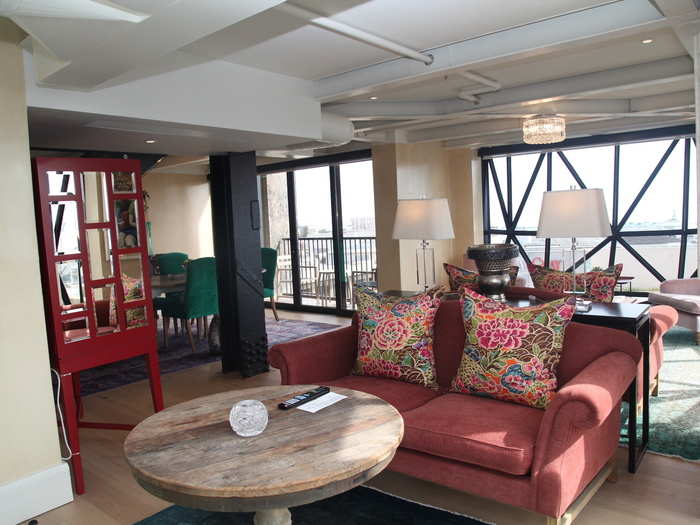
As I walked farther inward I saw not one but two sitting areas, chairs on the balcony, and a mysterious red chest clad with mirroring.
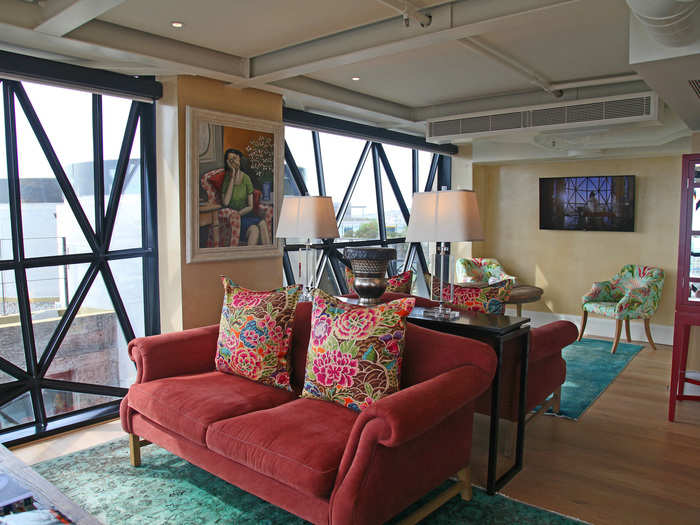
Irene BoaVentura, Duty Manager for the Royal Portfolio Group, explained everything I was seeing, like how the window shades work. Then she opened the red case and revealed the minibar.
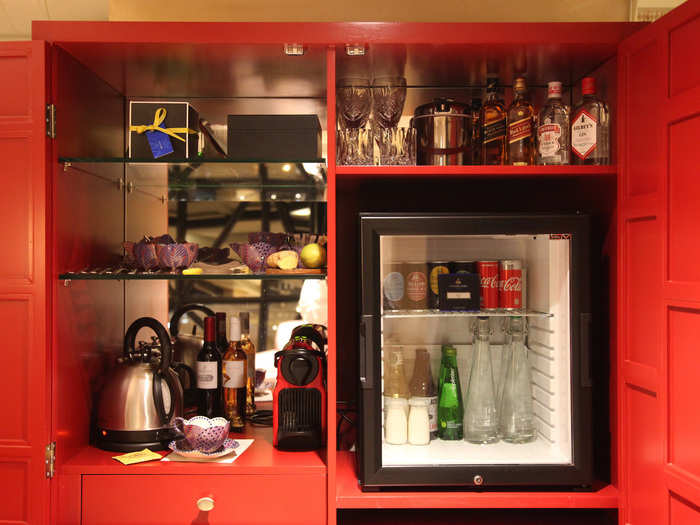
I immediately wrote it off as I usually don't lay a finger on the minibar for fear of setting off a trigger that will charge me $100 for a piece of candy. But then she said the word that made me come out of my dream-like state: free. Everything in the bar with the exception of four bottles of hard liquor is free for all guests.
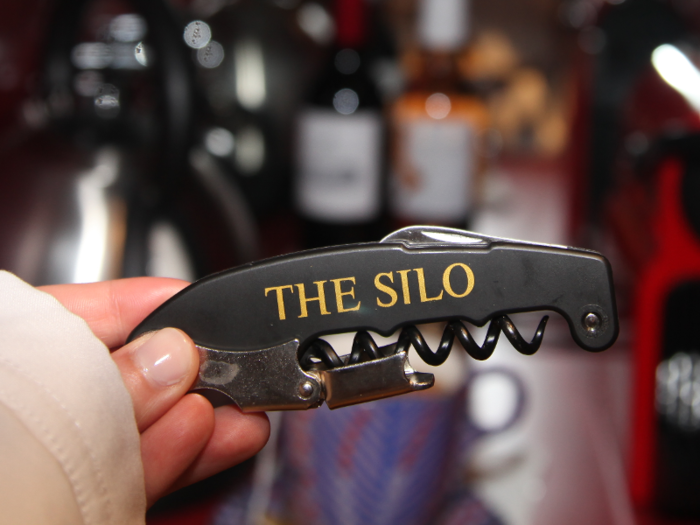
That included two bottles of wine, several soft drinks and water bottles, coffee, tea, fresh lime and ginger root for said free tea, and more. She also pointed out two little snack boxes with "Open Me" tags on them and called them a little surprise for later.

Then we climbed the steps ...
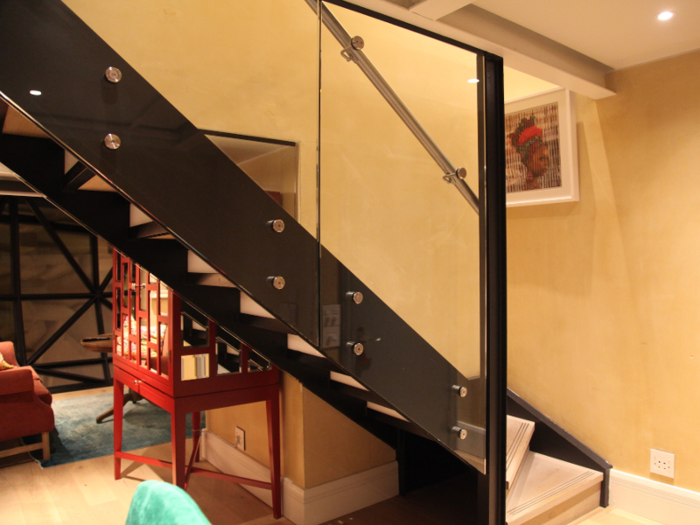
... and she showed me both bedrooms, pointed out all outlets with US compatible plugs, and showed me how to work the blinds in my bathroom.
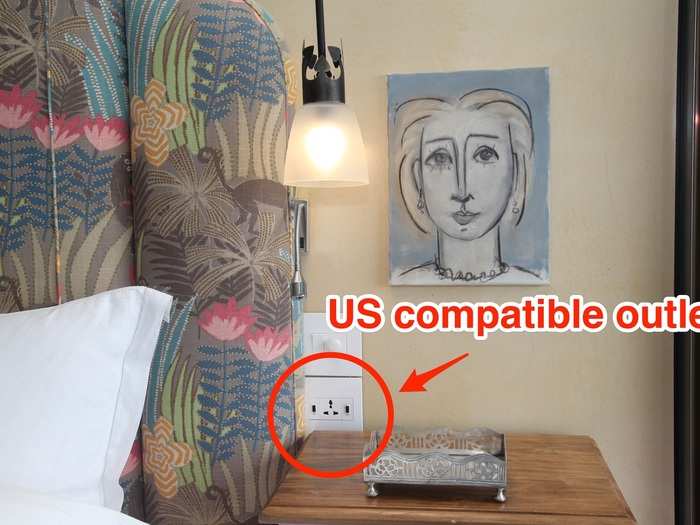
Irene left me to settle in, and I did just that. I spent the next couple of hours photographing every aspect of the suite and then working on some other projects — it was nice to have six seating options for that!
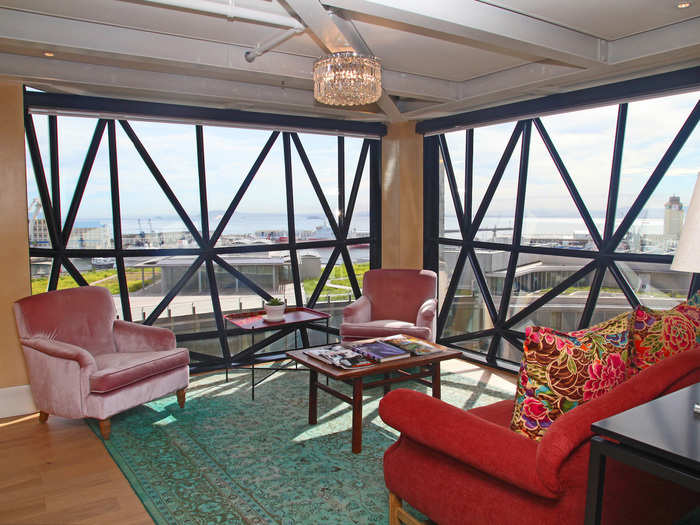
At around 1:15 p.m. my travel partner arrived from the US and we went on a proper tour of the hotel. Irene had us start with the sixth floor and work our way up. We began at The Willaston Bar ...
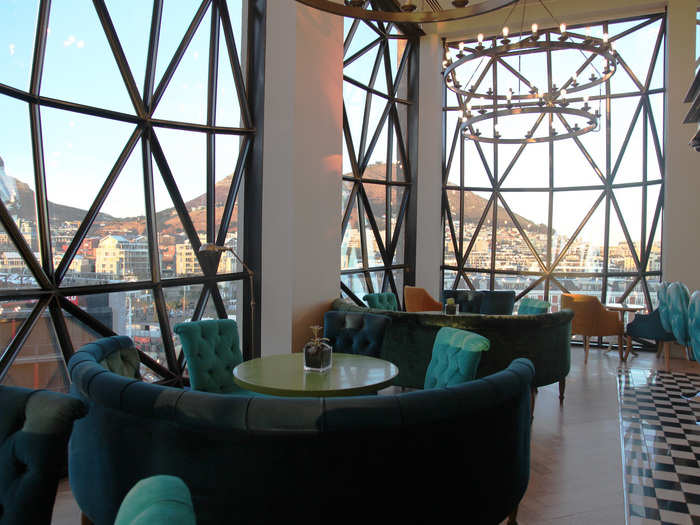
... which is one of three dining areas in the hotel. Guests can come to the jewel-toned lounge for early morning coffee, mid-day drinks, or dinner.
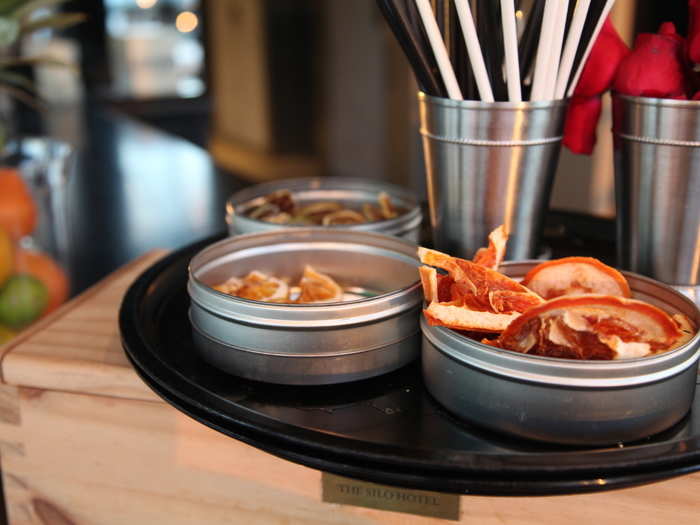
There's also an elevated lounge dubbed The Library that hangs over the bar. There are a few bookshelves, chairs, and tables for anyone to sit and look out the windows at Cape Town's centerpiece: Table Mountain.
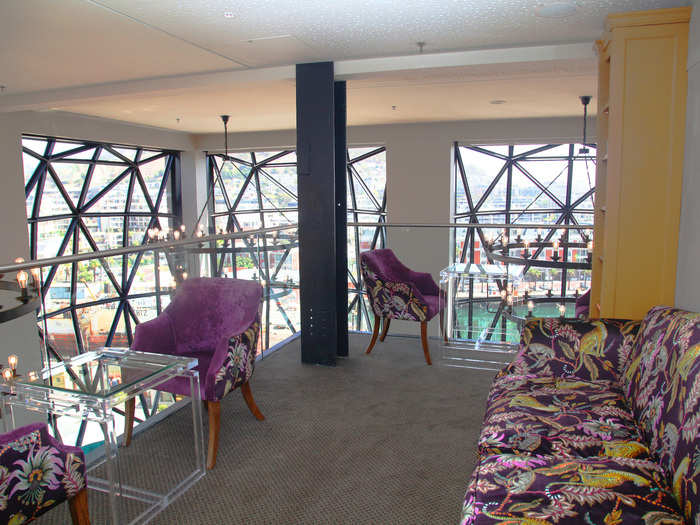
We moved on to the guest rooms upstairs. Every room is decorated completely differently with their own color schemes, unique pieces of art, and worldly collectibles. Some of the furniture was the same — like the mirrored chest and desk — but appeared in different colorways throughout.

There are two Royal Suites in the hotel. Each suite features two bedrooms, two full bathrooms, a living space, and a large balcony.
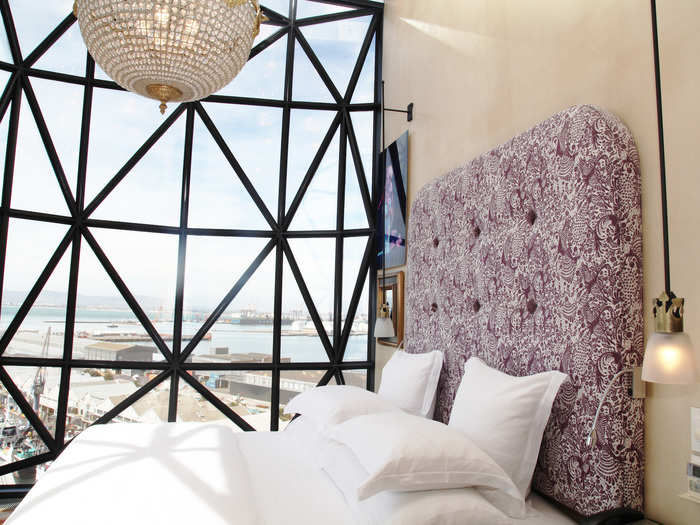
This is where I noticed the similarities in decoration across suites. Even though the Royal Suite had a different color scheme than my Family Suite, it featured the same mirrored mini bar in a different colorway.

I also got to take a look around the one-bedroom penthouse. At R151,200 ($10,790), this suite is the most expensive hotel room in the country.
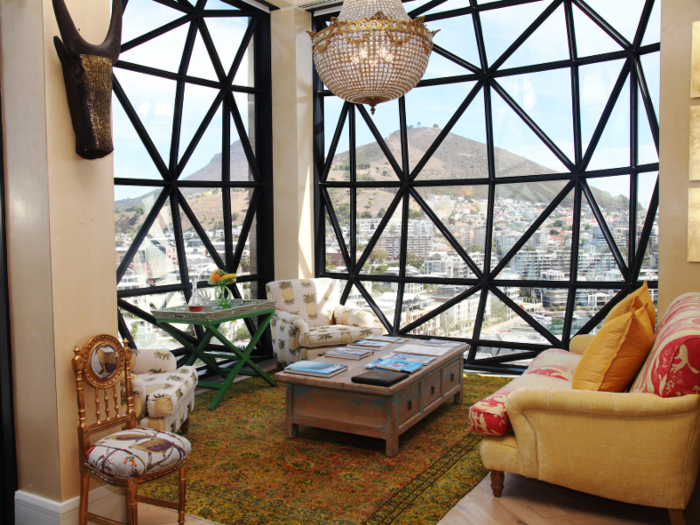
Source: Business Insider South Africa
If you've got almost 11 grand to spare, you can spend the night eating a private meal at your 10-seat dining table ...
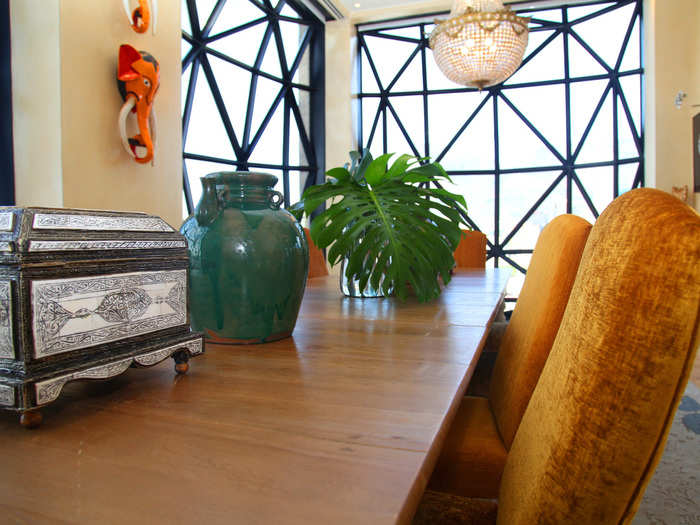
... watch a movie in your private theater ...
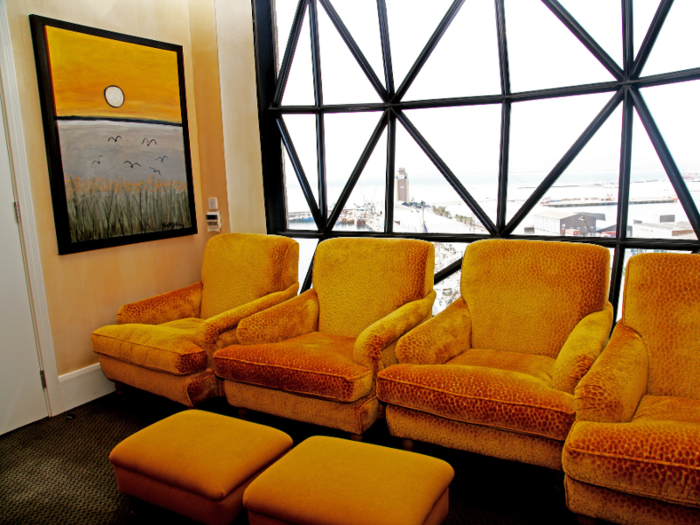
... and enjoy a massage on your in-room spa table.
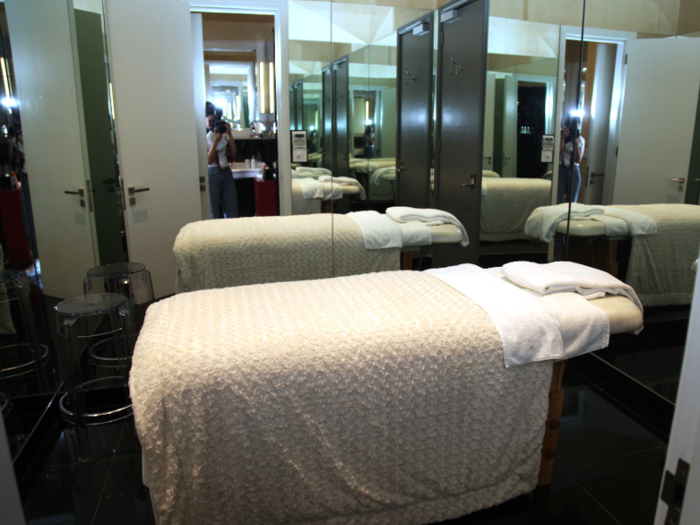
Every room and space in the hotel was decorated by Liz Biden, co-founder of The Royal Portfolio. She has a specific vision that produces excess in just the right amount.
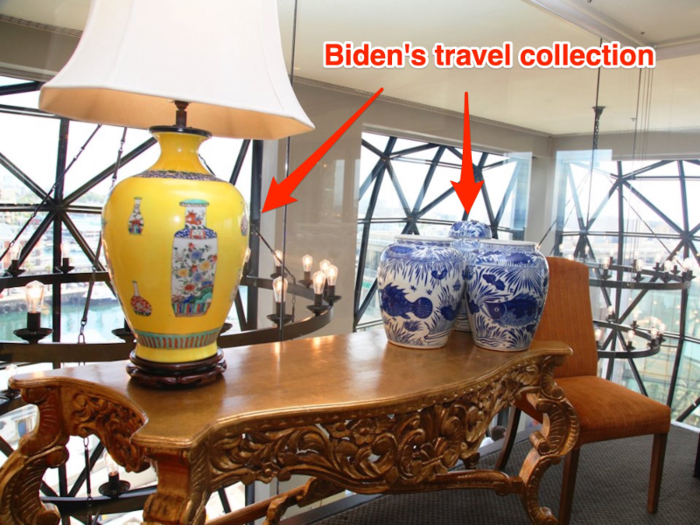
Source: The Royal Portfolio
Moving through the rooms felt like I was walking through the house of an ultra-wealthy collector with an eye for the extraordinary — a whole lot to look at, yet not too much at the same time. It was very my-speed.
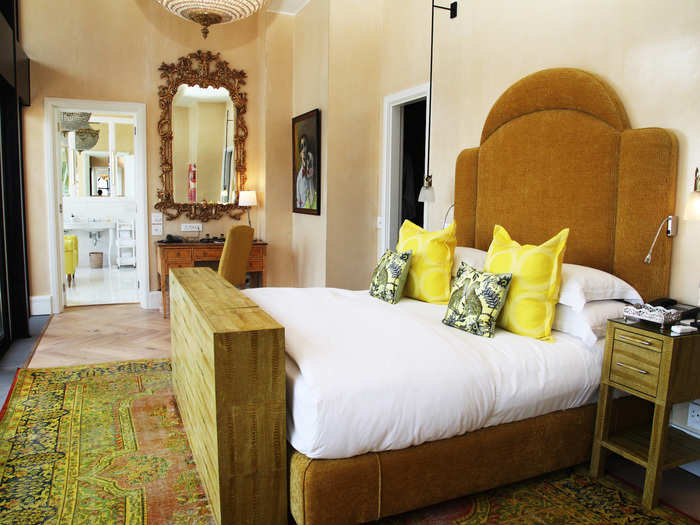
The differences and similarities throughout brought me back to the idea that this hotel is Cape Town elevated. It's an explosion of color and wacky quirks in the most sophisticated way.
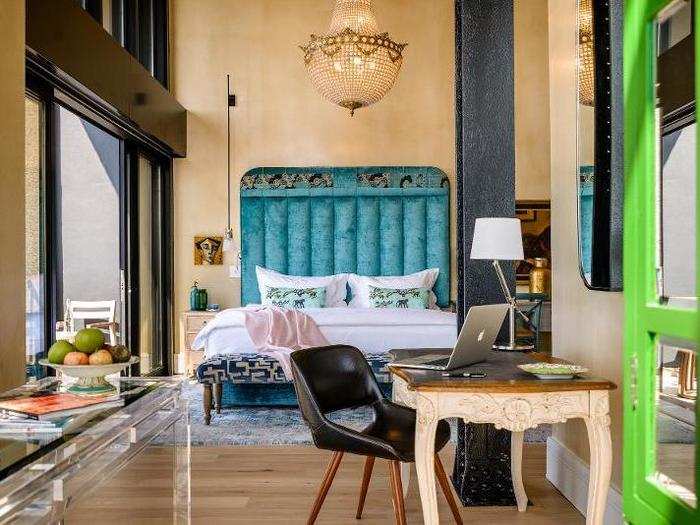
Moving onto the roof space we parted ways with Irene and explored the limited seating area ...
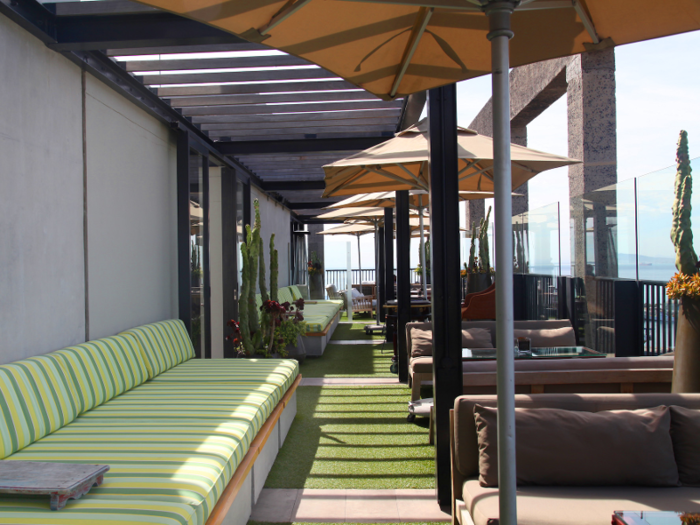
... rooftop grill ...
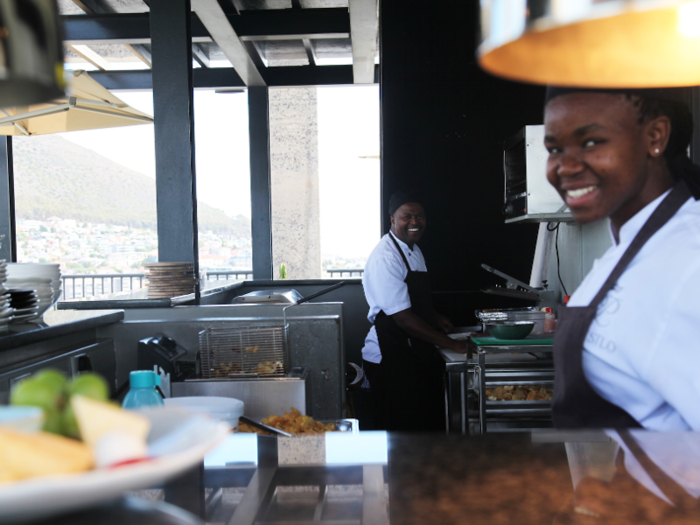
... and the Sky Terrace — an elevated portion of the roof offering a 360 degree view of the city.
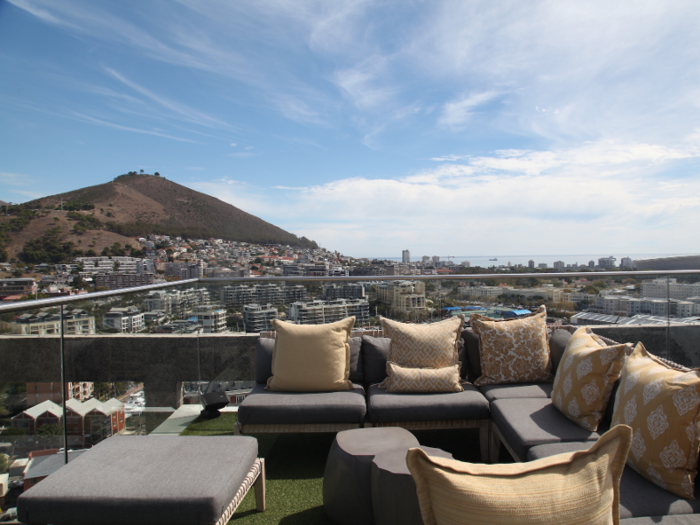
Back on the main roof deck level there's a glass-rimmed pool stretching out to the edge of the building. The pool itself is pretty small, but it's big enough for people to take a dip and cool off.
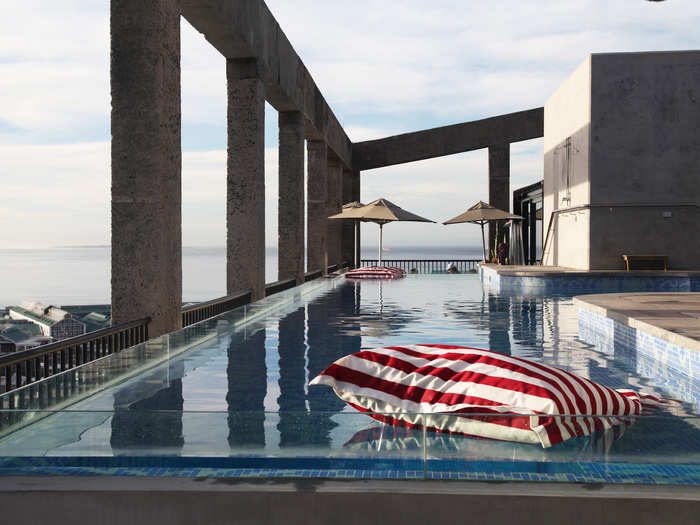
Plus, it's got a super modern feel with translucent siding and and an underwater view from one edge.

I spent the rest of the day's sunny hours working from a chaise with this view. It definitely wasn't a bad way to spend the end of a work week.
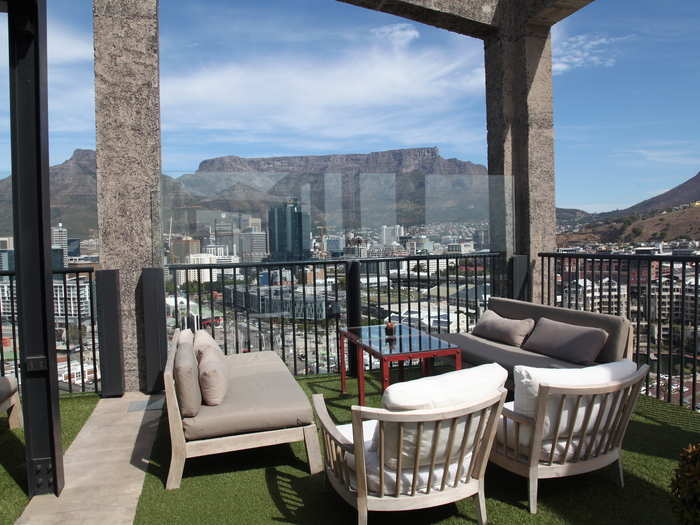
The bar had a fairly small snack menu. When it got to be around 4 p.m. we ordered a classic South African snack of biltong and droëwors, — two types of dried meat — which came with truffle chips for R160 ($11.34) — we saw them frying the chips on our tour and knew we had to try them. The dried meat is definitely an acquired taste.

While both are fairly salty, biltong tends to be softer and more moist in the center than droëwors, which are pretty dry throughout. You can get biltong at local shops made with one of several meats — the Kudu is my favorite.
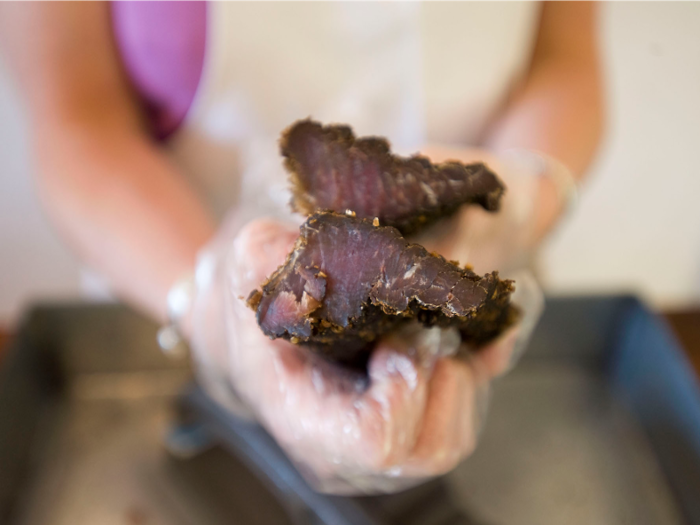
There were a few other people enjoying the pool and rooftop, but not many. As the night started to progress, though, more and more non-hotel residents made their way up.
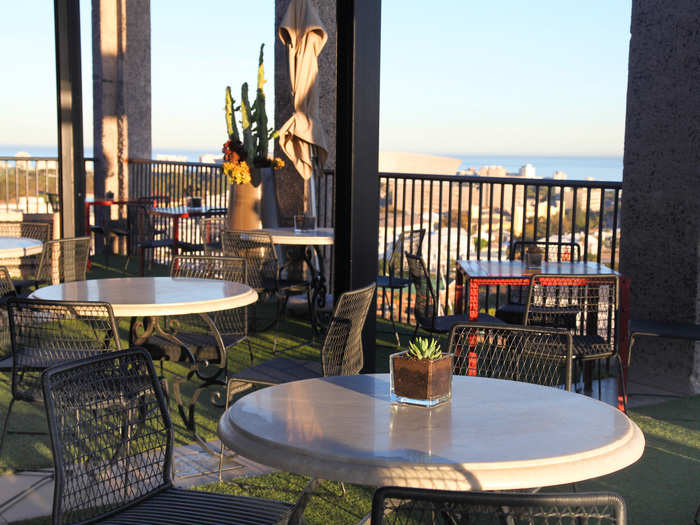
Hotel staffers told us we had to watch the sunset from the Sky Terrace, but there was a private event happening so we were stuck with the lowly luxury rooftop view — boo hoo.
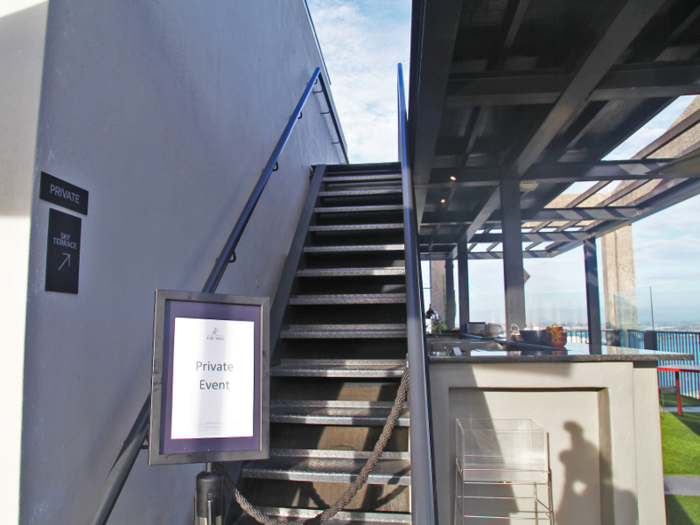
As a non-resident you can access the rooftop for sundowners — the South African term for sunset drinks — but you should make a reservation as much in advance as possible. James de Villiers, a reporter at Business Insider South Africa, came to join us and was almost turned away because the non-residents section was full. The residents section was basically empty, though.
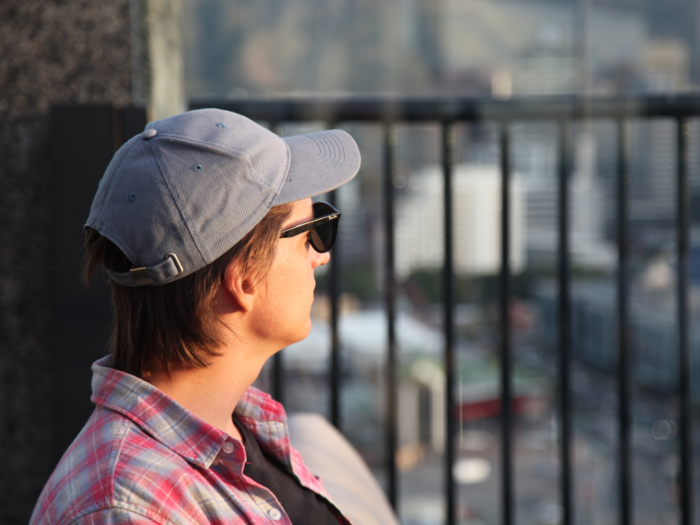
Because of the geography of Cape Town, there are certain parts of the city that may be just five minutes from one another, but offer completely different views. While The Silo's location wouldn't typically offer views of the sun hitting the horizon line, it's the tallest building in the area, which means we were able to see the sun over the buildings and Signal Hill.
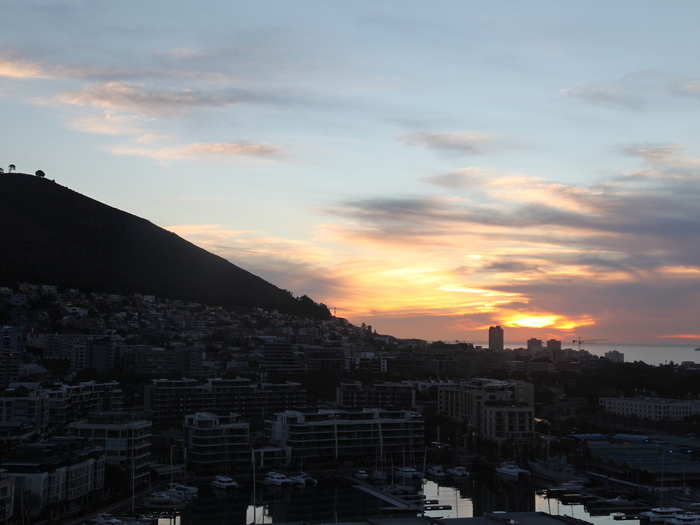
My experience with the culture around sundowners in Cape Town has taught me to sit back and enjoy the view, local wine, and meaningful conversation with friends.
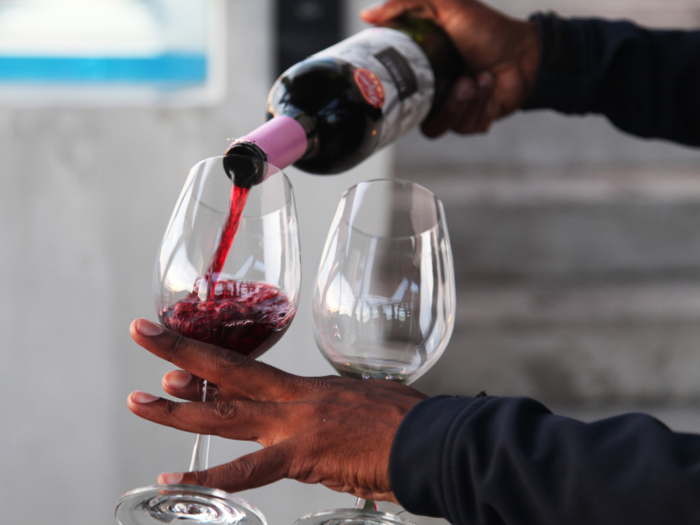
My experience with the culture around sunsets in the US has taught me to contort myself until my phone is in optimal photo-taking position, and talk about Instagram captions with friends. Since I was in mixed company — one friend from the states and another from Cape Town — we did a little bit of both.

There's honestly no shame in the sunset-photo game when the sky looks like this.
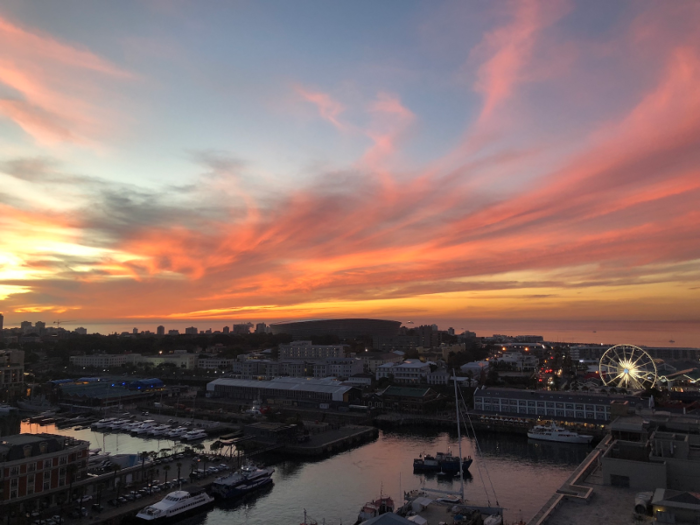
The Silo had an extensive wine list, so we picked a merlot from La Bri — one of the oldest wine farms in the Franschhoek Valley, which is part of the Cape Winelands.
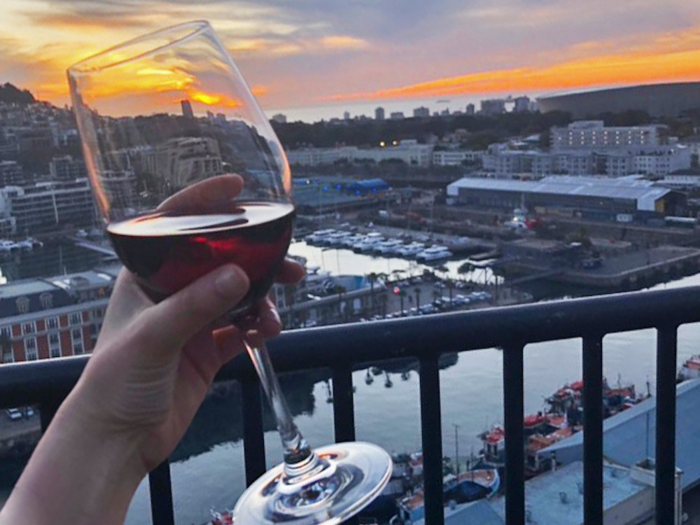
Source: La Bri
The sun set at 7 p.m., which meant we had a little under an hour to get ready for our dinner reservation at Granary Café — the hotel's main restaurant. We filled that time by popping our "welcome" bubbly ...
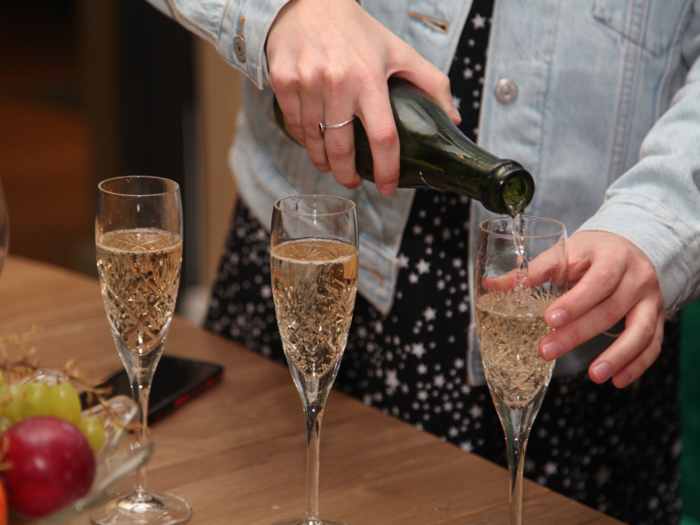
... and making a toast of the complimentary sparkling wine and fruit at our suite's dining room table. The crystal flutes were an appreciated touch that added to the luxury of it all.
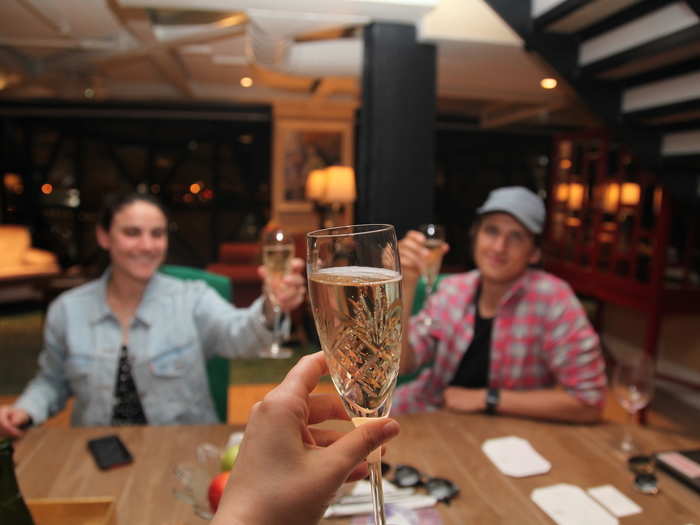
When I first arrived at the hotel, the bottle of sparkling wine was in a bucket of ice — which the hotel sets up for all guests — on the dining room table with a welcome note. When we came back from the roof we thought it had been removed from the room since we didn't drink it yet. But of course the staff wouldn't just take it away, — psh! — they actually put it in the refrigerator to keep cold after the ice melted.
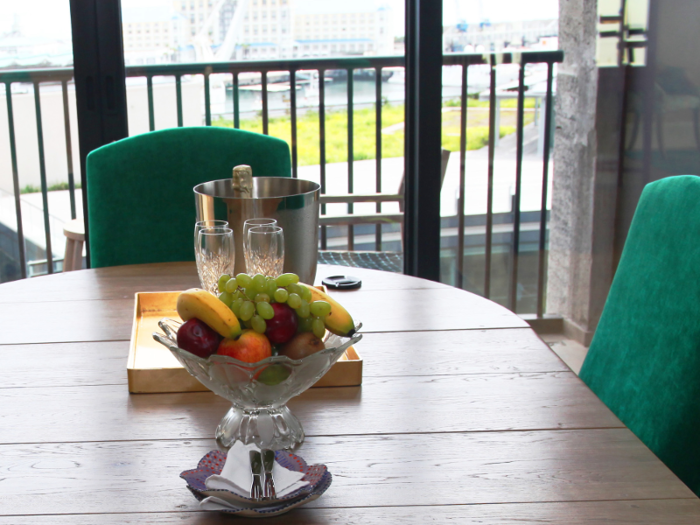
While Granary Café is a relatively small restaurant, Irene pointed out that most guests will dine out at one of the city's many world-renowned restaurants. But rest assured, the ones who choose to stay in aren't cheated out of that world-class experience.
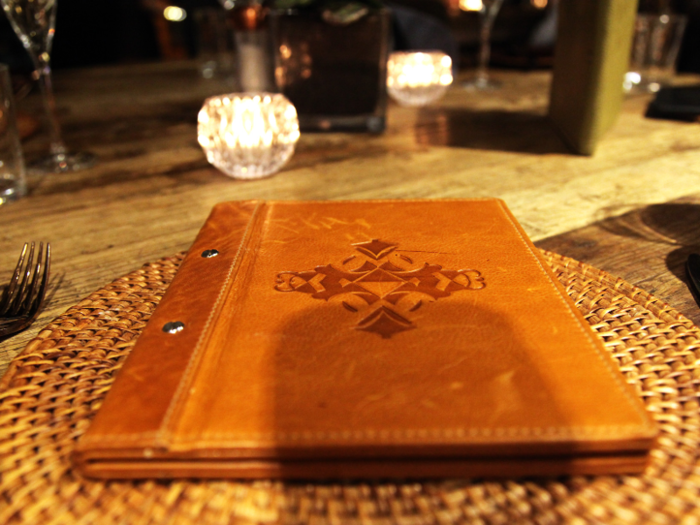
Source: Time Out
The restaurant is run by Executive Chef Veronica Canha-Hibbert and its menu was overwhelming. I was so happy James stayed for dinner because that meant we got to try more things — starting with cocktails.
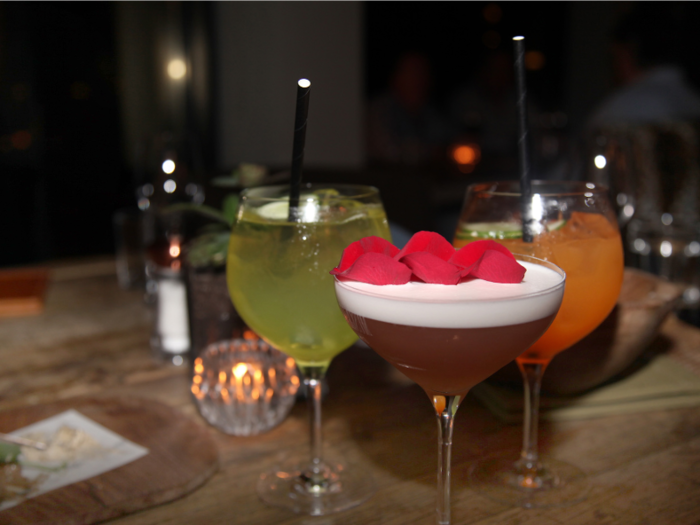
If something says "signature" on the menu there's a good chance I'm ordering it. The Rose Ginvino cocktail had Musgrave Pink Gin, chenin blanc, lime, grapefruit, rose syrup, and egg white. It was refreshing and tart — not sweet at all — and the rose petals put it over the edge as sublime. A drink like this at a restaurant of this caliber would have probably cost $16 in New York — it cost R120 ($8.57).
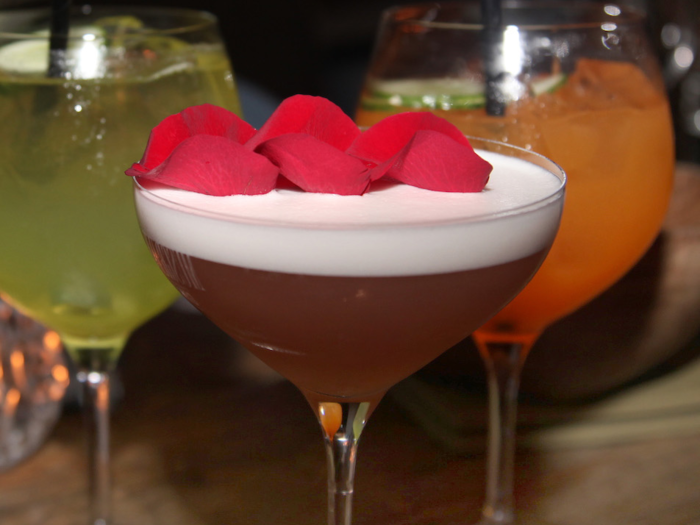
The true mark of an innovative restaurant is the free bread and butter that comes to the table — I firmly stand by that totally opinionated claim. The Granary Cafe delivered with its roll variety — which included an onion ciabatta — and two different spreads: one tasted like truffle but was actually black garlic butter and the other was a mushroom aioli.
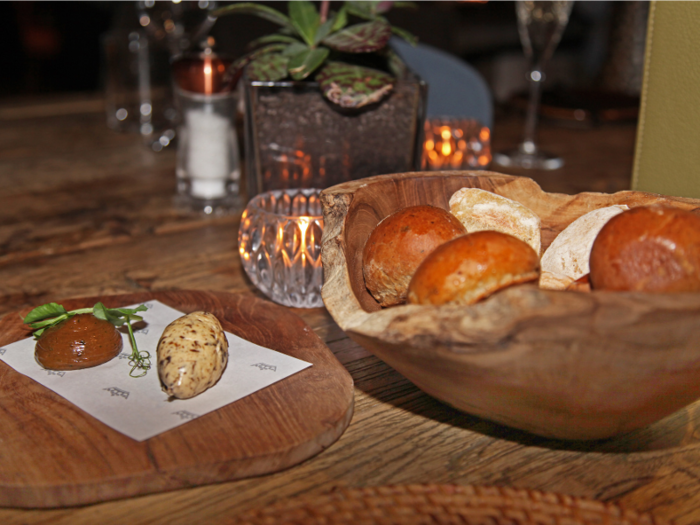
We ordered butternut squash gnocchi and an asparagus dish to start, main dishes of three different proteins including one with springbok — a classic South African game meat — and one dish called Cape Seafood Curry — the flavors were inspired by city's Malay quarter. Other than those two dishes, I didn't taste anything unique to Capetonian cuisine.
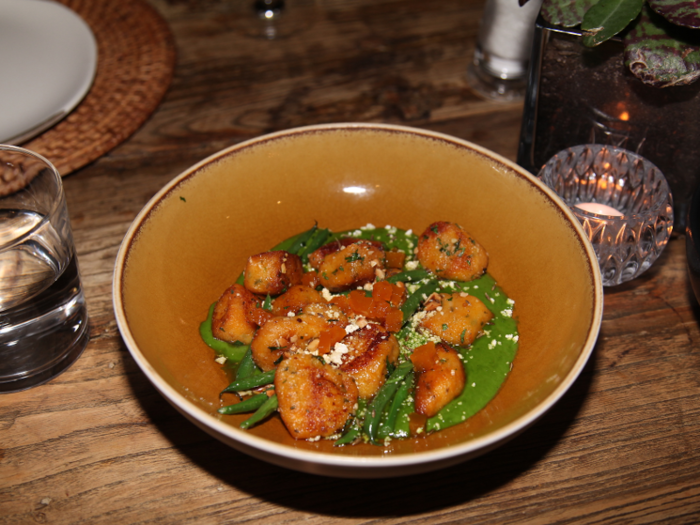
We also ordered two desserts for sharing. Of course, we just passed everything around the table anyway. The staff thanked us — and everyone else at the restaurant — for joining them with these complimentary after-dessert desserts.
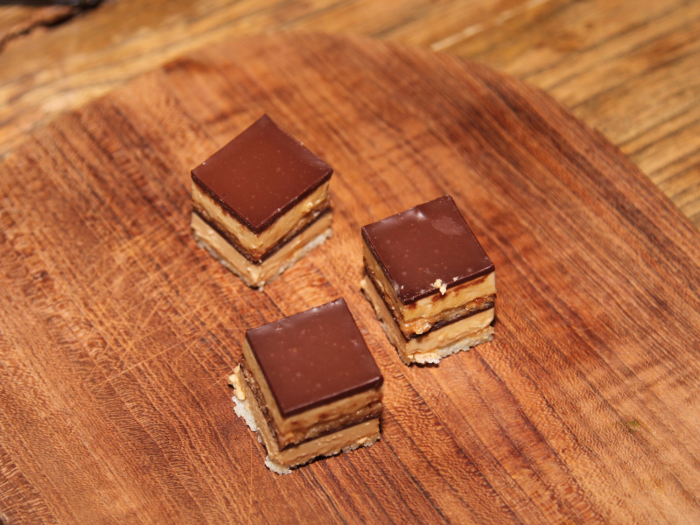
The food was great, but I understand why guests don't necessarily feel compelled to stay. There are so many unbelievable restaurants in Cape Town, and if you're only in town for a few nights it makes sense to venture outside the hotel.
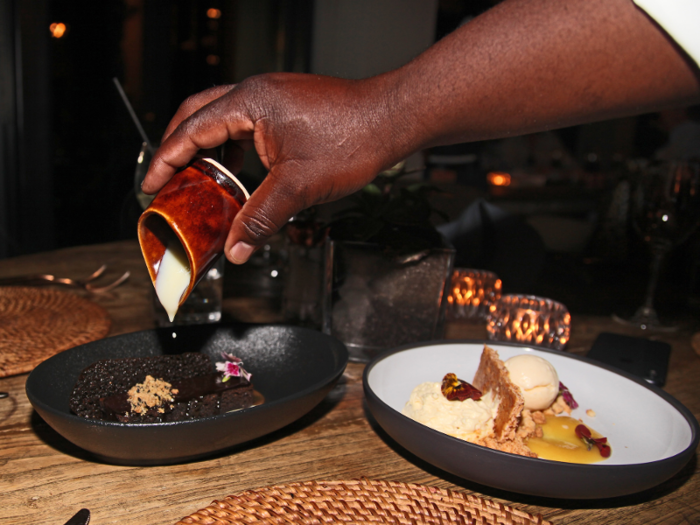
When we got back to our suite we saw that the cleaning staff had been there — which marked the second time they visited since we checked in. They left cookies on our bedside tables ...
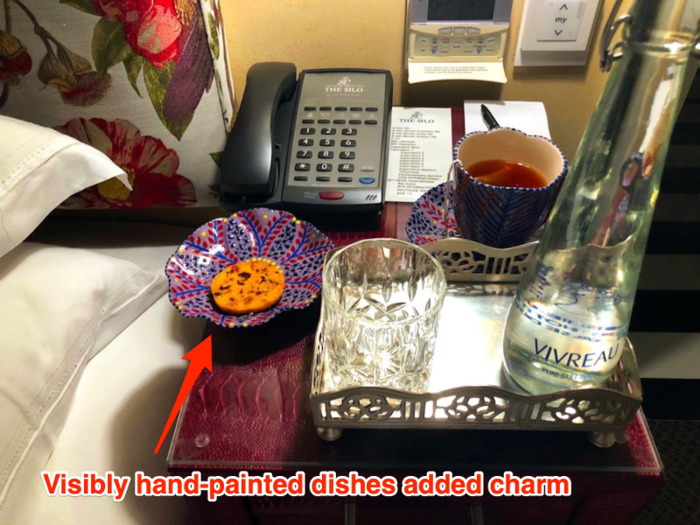
... and they had even straightened up our clothes. They arranged all the grooming accessories my friend had left out onto a towel on her desk. Even her retainer case was lined up perfectly above her hairbrush — the staff's attention to detail was truly amazing.
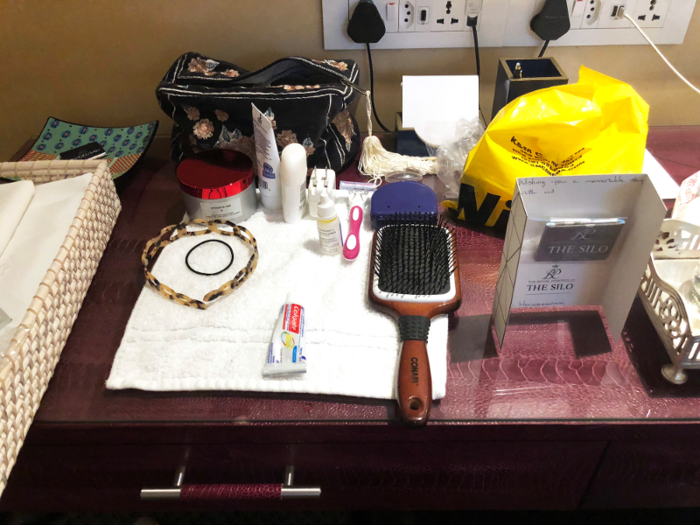
The bathroom — which was roughly the size of my bedroom in New York City — had a beautiful bathtub situated right up against a pillowing window.
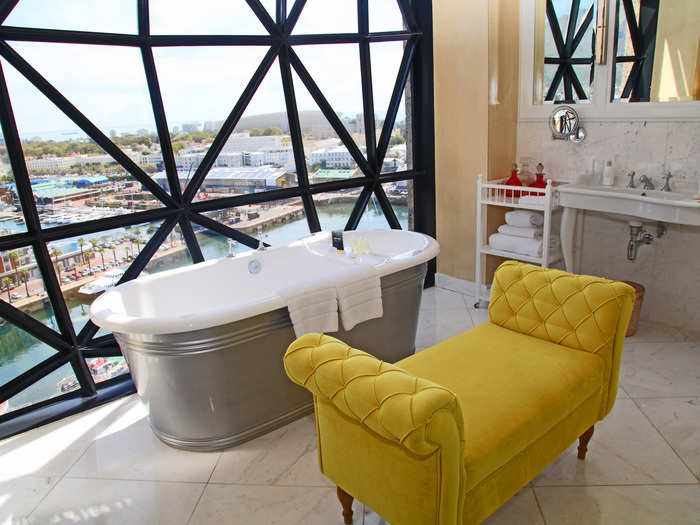
The view from our suite's living room wasn't spectacular — it looked out onto neighboring buildings and was right up against the top of the Zeitz MOCAA museum.
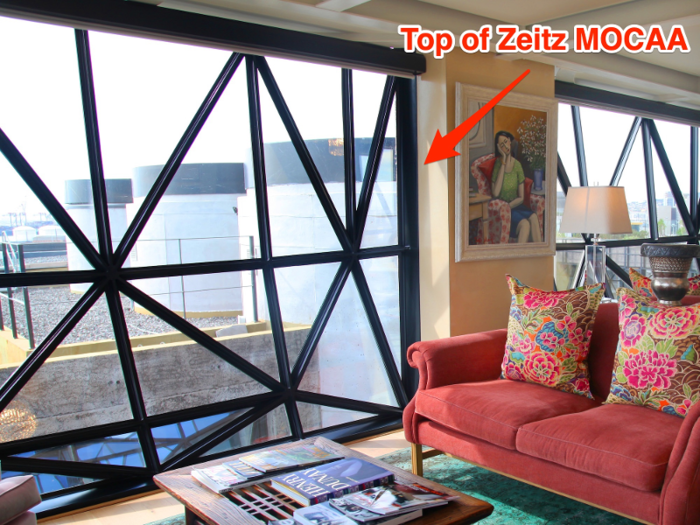
The room above us, though, had a better view that looked down into the Zeitz MOCAA sculpture garden seen here.
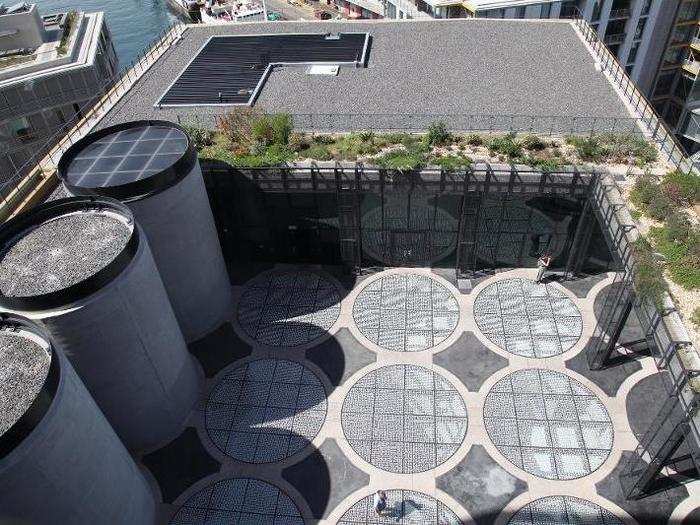
But it was still pretty. I wanted to take a bath — especially with the gorgeous vials of bubble juice and bath salts all set up — ...
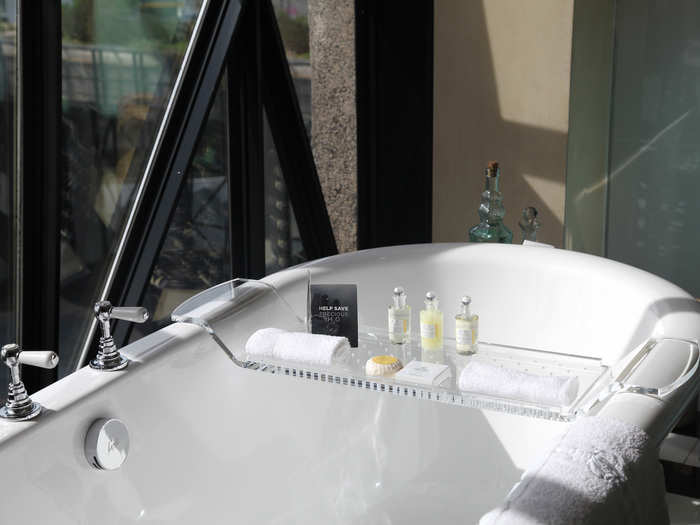
... but my conscience stopped me. Cape Town has been dealing with a water crisis where "Day Zero" — the date that will mark the day this major coastal city runs out of fresh water — is still a looming possibility.

Source: Business Insider, Business Insider, Business Insider, TIME
Even though the city is no longer in a Level 4 crisis — where water was limited on a scale of 100 liters per person, per day — there are still signs everywhere asking people to be mindful of how much water they use.
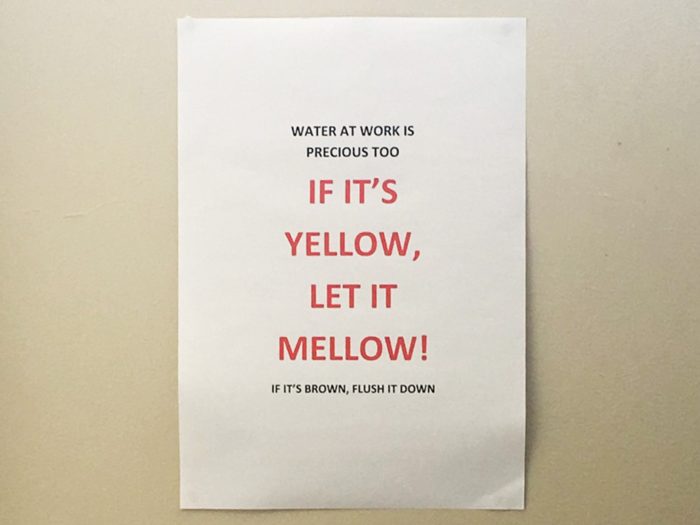
Source: Pulitzer Center
Signs reading "Every drop counts" and "If it's yellow, let it mellow" are all over the city, and luxury establishments are no exception. Hotels also ask guests to re-use their bath towels to reduce the amount of water used for doing laundry.
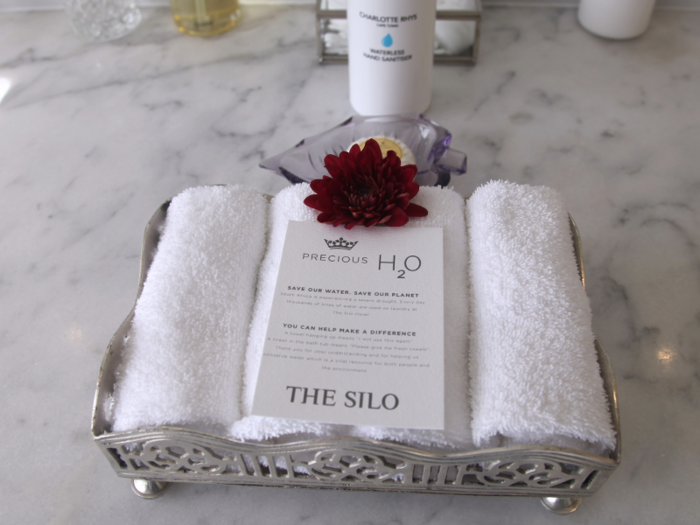
So I couldn't bring myself to fill up a large bathtub. Thankfully the shower also faced the window so there was no loss on that front.
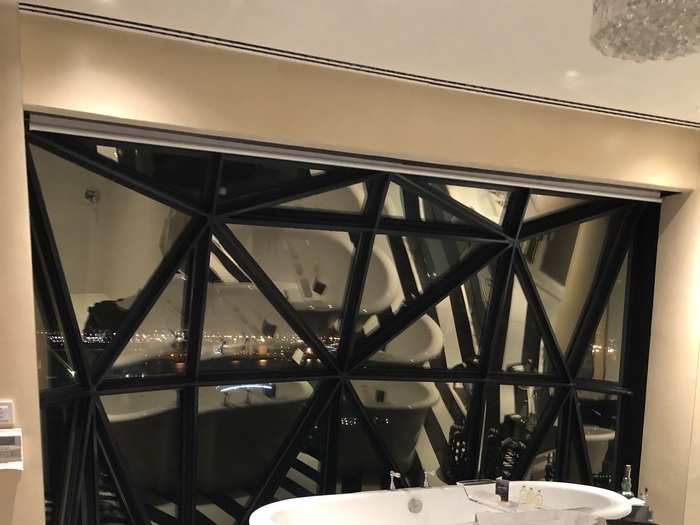
These signs are proof that even the most luxurious places in Cape Town can't escape some of the obstacles that are part of the reality of life here — which includes more than just the water crisis.
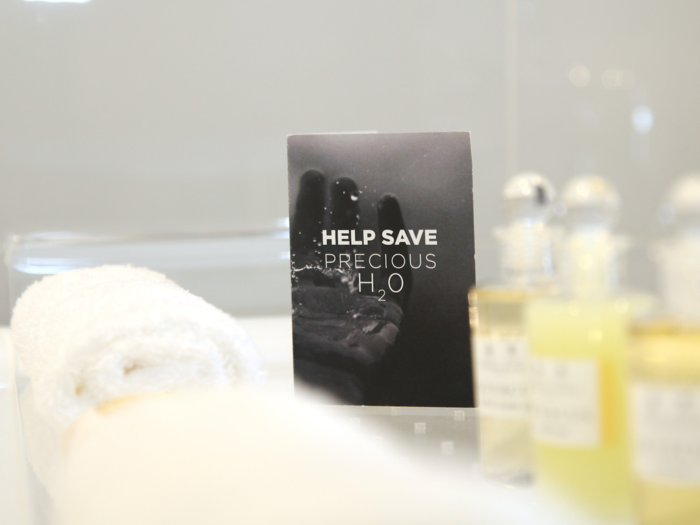
This sign greeted me as I first entered the hotel on the ground floor, letting me know that I wasn't immune to load-shedding — controlled power outages across the country in order to reduce the risk of a nation-wide blackout — here.

Source: Eskom
Read more about load shedding: Business Insider South Africa
Despite the power restrictions, generators kept luxuries like heated towel racks working. The towel racks were a cozy touch, but I learned they were pretty standard across several levels of accommodation in the city.
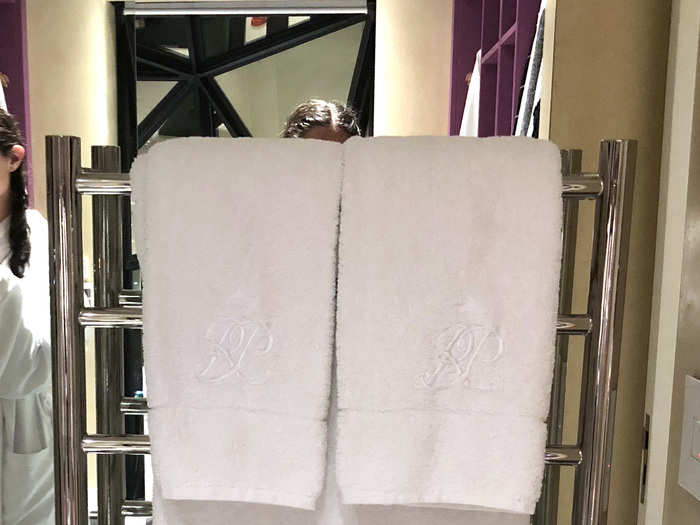
After getting comfy in one of two different robes hanging in my bathroom, I went to make a before-bed cup of Rooibos tea and was happy to find that the kettle in the minibar was already filled with water! It's the little things like this that brought me back to a luxurious state of mind.
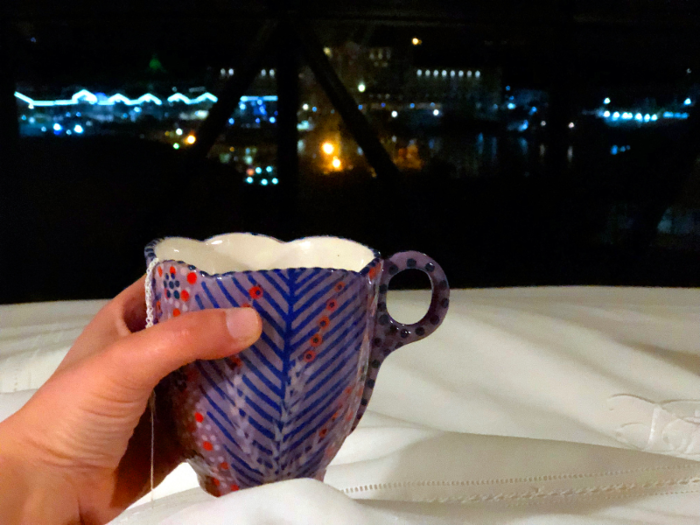
The TV only had a few channels, which didn't bother me too much because I was just looking for some background noise to fall asleep to. But if I was paying R36,700 ($2,627.63) per night on this suite, I think I'd want to be able to find something to watch.
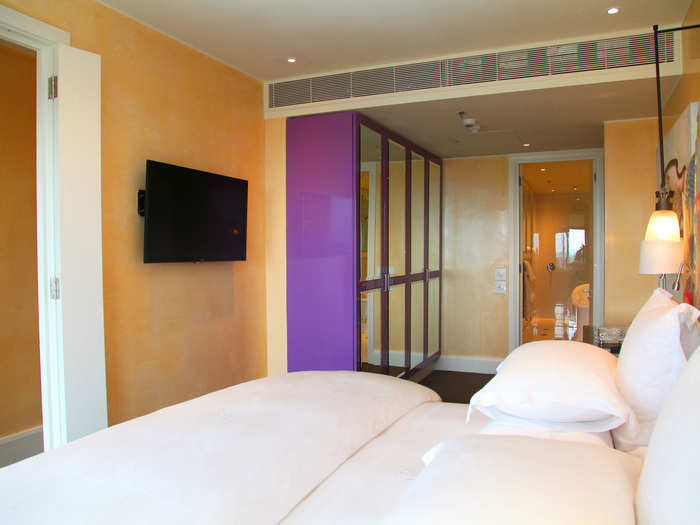
The Silo staff kept stressing how great the sunrise would be from the Sky Terrace, so I set my alarm for 5:45 a.m. I was able to watch the beginning of it from my room — thank you giant, east-facing windows — and then headed to the roof for the rest.
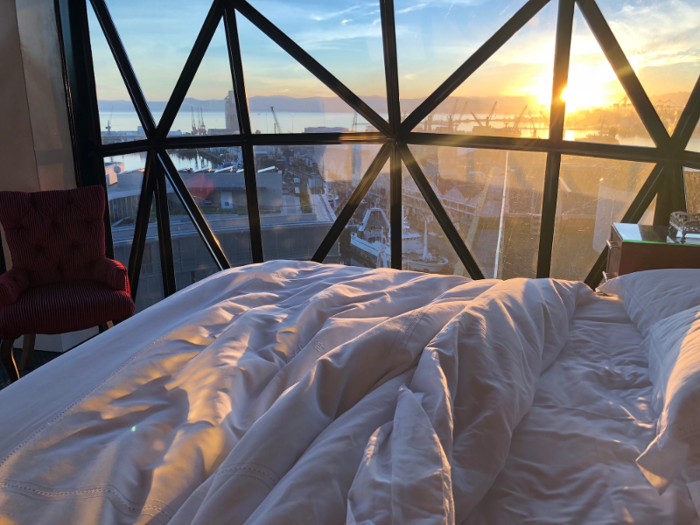
It was definitely spectacular from the height of the Sky Terrace, but walking out to the edge of the harbor would have also been great.
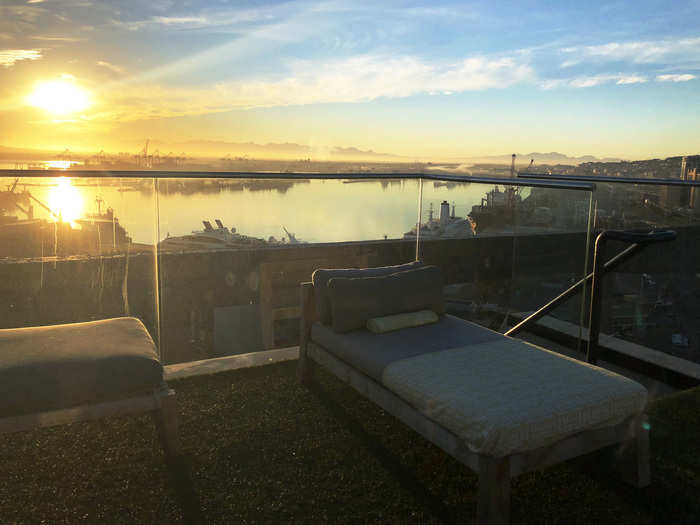
From there I went to check out the spa, the gym — which has a great view of Table Mountain from the machines — ...

... and what's known as The Vault. This is the hotel entrance from the underground garage, and it also acts as a private art gallery — the pieces on these walls are for sale.
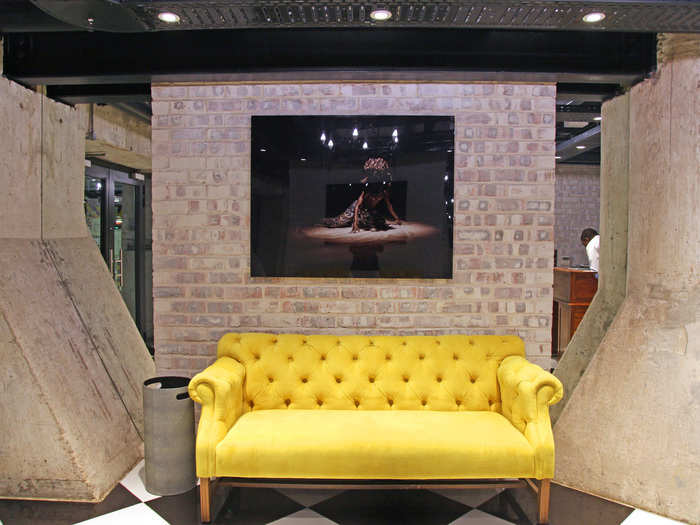
I also took a walk around the grounds surrounding the hotel. The immediate area dubbed The Silo District has been built up with some shops, galleries, and trendy signage and sculptures like this SILOVE piece.
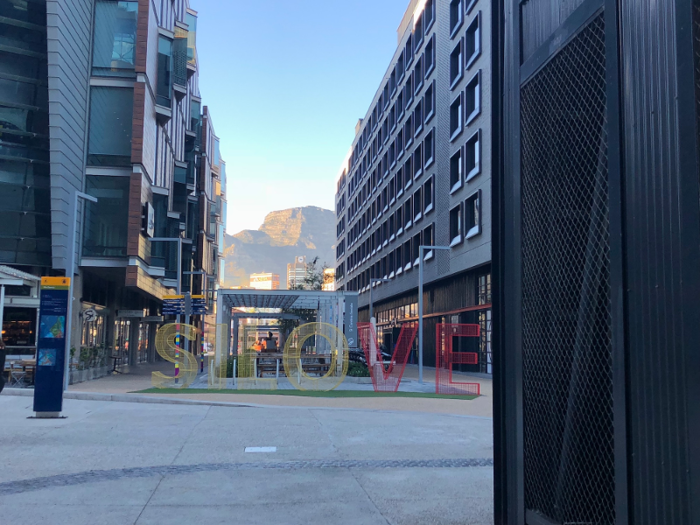
And there were people outside enjoying these also-trendy spinning stools.

After working up an appetite, it was time for breakfast. Of course, it started with the continental display again, but Alex also brought us a green juice that was super refreshing.
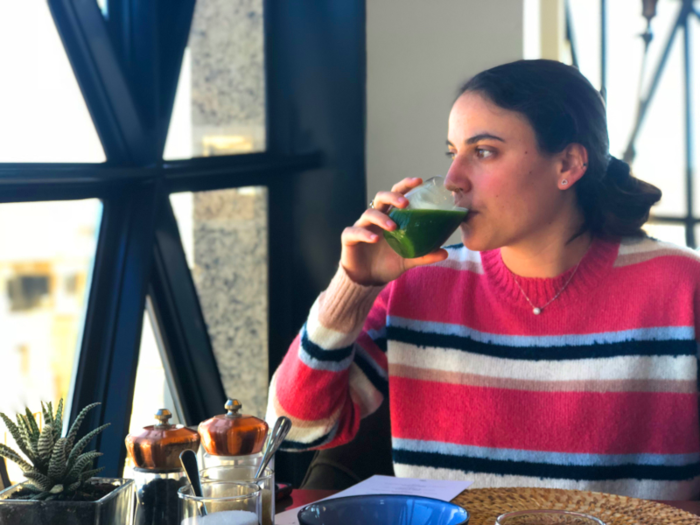
I decided to try out one of the menu items this time. While I watched the avocado toast go by for the person dining next to us, I thought hummus toast was more of a unique choice. Plus, it was seasoned with Za'atar, which really made my decision.
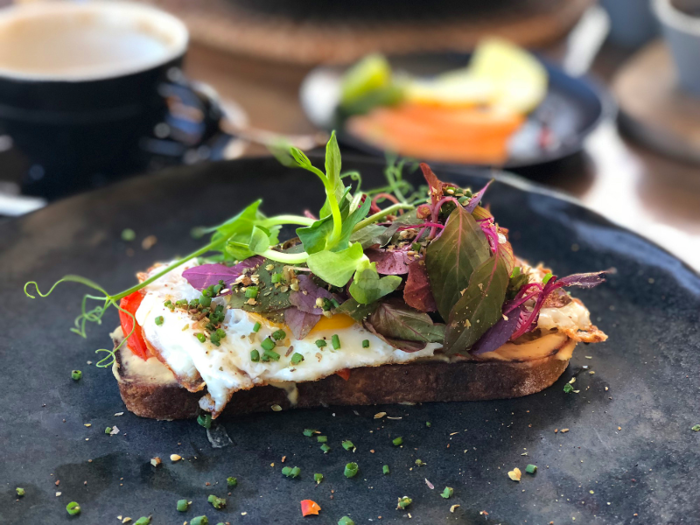
There was someone checking into our suite later that day, so we had to rush back to the room after breakfast and pack up. Typically I live out of my suitcase when I travel, but there was so much closet space that I hung up my jackets.
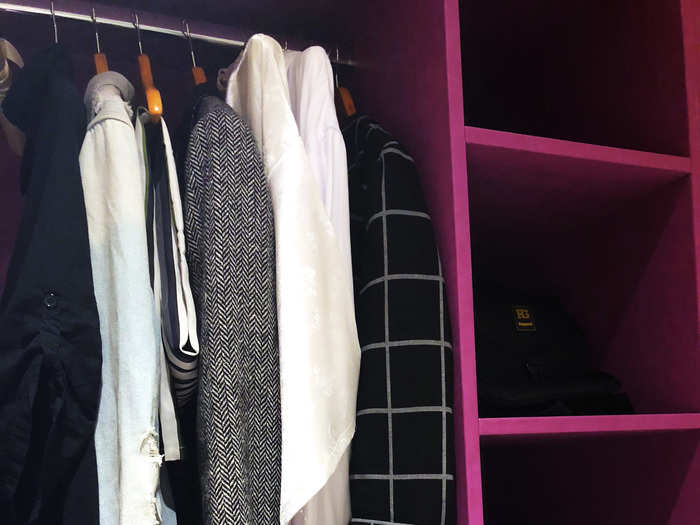
As I said goodbye to this suite I could never afford on my own, I thought about whether the hotel lived up to the hype and if I'd spend the money on it if I had the means.
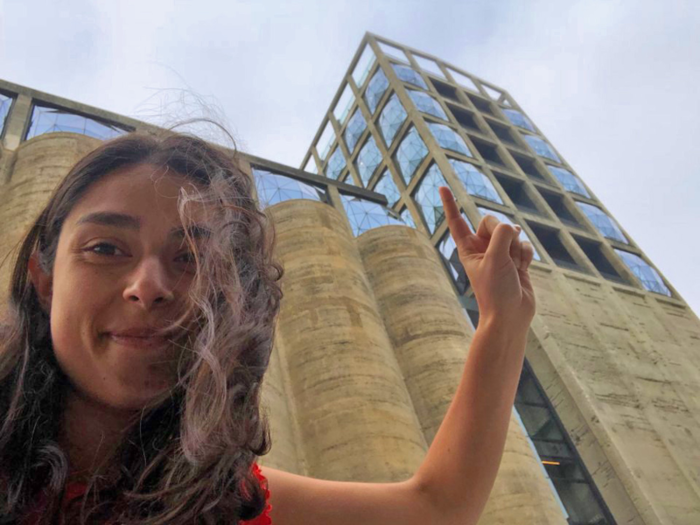
Ultimately, the hotel lived up to its hype thanks to its next-level service, modern-art-museum-like decor that embodies Cape Town, and stunning views that are among the best in Cape Town.
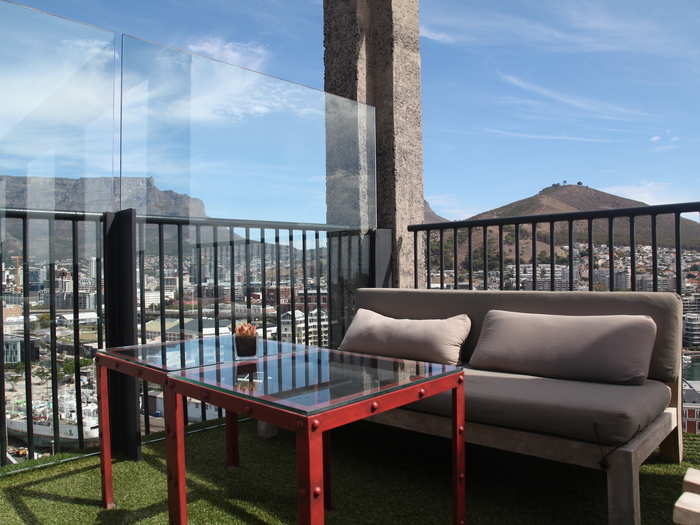
If you're looking to spend upward of $1,000 on a hotel, The Silo is where you should do it. Its bright, colorful, eclectic vibe is truly in line with the spirit of the city, and there's no reason why you should settle for a generic hotel that looks like it could be anywhere in the world.

But, having stayed in six different hotels around Cape Town over the past four years — now ranging from ultra-luxe accommodations to backpacker accommodations — I don't think I'd spend the $2,600 a night it costs for a suite again.
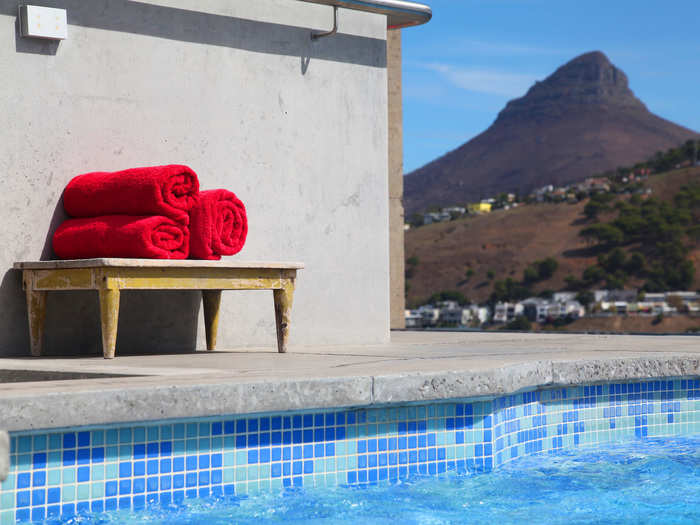
I've stayed in another boutique hotel in the Waterfront with tons of charm, equally exceptional staff, and lovely amenities for closer to $300. So, although The Silo Hotel is beautiful, luxurious, and uniquely Cape Town, I'd rather spend the difference on other Cape Town experiences.
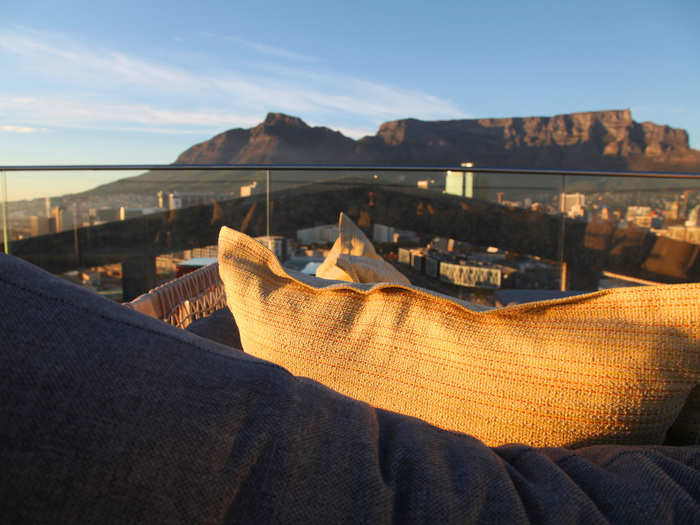
Source: Newmark, The Royal Portfolio
Popular Right Now
Popular Keywords
Advertisement